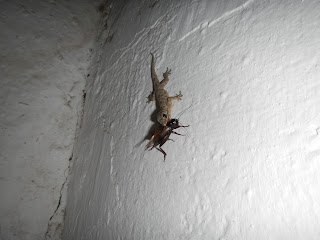Victoria Falls - Whitewater rafting
Victoria Falls is in Zambia and has been described as one of the natural wonders of the world. There are lots of adrenaline adventures centered around the falls. I'm scared of water. I hate getting dunked as I have no ability to keep the water out of my nasal passages. Hence, I figured whitewater rafting the Zambezi would be a great idea. In truth, I try to do things that make me uncomfortable now. This seemed like a perfect opportunity to face some fears.
The Zambezi is one of the best rivers to raft in the world. The water is really warm and the lower Zambezi has 25 rapids in 30 km, you almost can't take a breath before the next one is before you. It has the most class 5 rapids in such a short stretch. The river is also infested with freshwater crocodiles, which were basking along the banks of the river. Thankfully none of them bothered us. Avoiding crocs while trying to stay afloat in a rapid would have been difficult. The river itself is guarded by a river god called Nyami Nyami, which is represented by a serpent. Some kayakers that regularly run the river wear pendants for safe passage.
November 15, 2012 the day I went rafting was one of my top 5 days I've ever had. It was amazing. At the very first rapid we got stuck. The raft was shaking and none of us knew what to do. The rapid eventually spit us out and we collected our lost passenger. At the second rapid Tom went over. He looked pretty concerned as he disappeared into the waves. The river was intense. When we hit the first class 5 the drop into the waves was so terrifying I screamed.
At rapid #10, the gnashing jaws of death, the left side of the boat (including myself) was swept away. Kirsty and I swam and she somehow ended up with both of our paddles. Falling in was so much fun! I wasn't afraid, just focused on not drowning. I was collected by our camera man at the end of rapid. What a rush.
We were given the chance to boogie board through the rapids. Alene and I decided to take on a class 4 with only flippers and a styrafoam board. It was scary. You're thrown around and there is no way to steer, really nothing you can do. It was fun, I'm glad I did it, but I was definitely shaking at the end.
Rapid #18, Oblivian, proved to be our raft's undoing. It's nicknamed popcorn, because the people in the boat will pop out one by one and there is a 50/50 chance of the raft flipping. We made it over the first waves and felt like seasoned pros. Before we could celebrate, the second wave flipped the entire raft over. I was caught under the raft for a few seconds before the current pulled me out. Swimming through the entire class 5 was terrifying, you can't breath, you can't control yourself. It was a blast. Once we got back onto the boat, we did a high five with our paddles, hit a rock and Kirsty went flying back into the water. It happened so quickly, the shock didn't have time to register on her face. It gave us all a good laugh.
 |
| Rapid 2 and 3 from above. |
By the end of the trip I was paddling in the front, fear gone. I now wear a Nyami Nyami pendant around my neck in homage to the river that helped me face my fear of water. I don't think it'll bother me anymore.
































